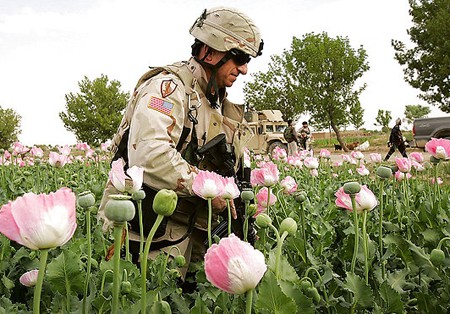By JULIEN MERCILLE
So Mr. Obama is getting ready to surge-again-in Afghanistan partly to fight opium trafficking. But an important report just released by the World Health Organization entitled The Global Tobacco Epidemic shows that Obama cannot possibly be waging a “war on drugs”-or else he would direct his attention towards tobacco executives and away from the Taliban [1].

RAWA: Since 2001 the opium cultivation increased over 4,400%. Under the US/NATO, Afghanistan became world largest opium producer, which produces 93% of world opium.
Illegal drugs kill about 200,000 people every year, including deaths due to HIV/AIDS transmission through needles. Of this, opiates account for 100,000, a number recently used by the United Nations Office on Drugs and Crime to justify the targeting of Afghan drug traffickers and Taliban [2].
But according to the WHO, tobacco kills about 5.4 million people every year–1 in 10 adult deaths worldwide-and more than tuberculosis, HIV/AIDS and malaria combined. Alcohol accounts for another 1.8 million deaths yearly. In the 20th century, the tobacco epidemic killed 100 million people-and during the 21st century, the number could reach one billion. Second-hand smoke alone kills three times more people (600,000) than illegal drugs.
However, tobacco industry leaders are treated very differently from the Taliban who, lest we forget, only capture about 4% of the value of Afghanistan’s drug industry, or $125 million per year according to UNODC. First, tobacco has not been made illegal, in fact it is the only legal consumer product which kills when it is used entirely as intended, meaning that around 500 million people alive today will die because of it. But although Western governments collect $110 billion in tobacco taxes each year, they only spend 0.3% of that on tobacco control. This is even if tobacco-related deaths result in lost economic opportunities, which in the United States are estimated at $92 billion a year, in addition to increasing health care costs by $81 billion annually. Worried about health care reform costs? Tackle smoking.
The cigarette industry spends tens of billions of dollars a year on marketing, but no one would think of giving the privilege to the Taliban of conducting an advertising campaign in the West for opium products. In developing countries, tobacco corporations now target women and teenagers and pressure governments to block marketing restrictions and tax increases, just as they did for decades in developed countries.
In the late 1990s, the “Tobacco Papers” were released as a result of legal action against cigarette manufacturers, comparable to the Vietnam War years “Pentagon Papers” [3]. Six million secret internal documents became available to the public, revealing and confirming much about their commercial strategies. For instance, their executives noted that they should not be too depressed about declining traditional markets because “there are areas of strong growth, particularly in Asia and Africa… It is an exciting prospect” (British American Tobacco chairman, 1990). Philip Morris stated that “Today’s teenager is tomorrow’s potential regular customer… The smoking patterns of teenagers are particularly important to Philip Morris.” As a result, by 2030, more than 80% of tobacco deaths will be in developing countries. As many as 100 million Chinese men currently under age 30 will die from tobacco use.
Another reason why there can’t be a “war on drugs” is that successive American governments have consistently used the least effective means to deal with the problem. A widely cited 1994 RAND study showed that targeting “source countries” is 23 times less effective than providing treatment for addicts domestically, the most effective method [4]. Rational policy-makers, at least over decades, should have shifted policy towards the most effective approach if truly concerned with fighting drugs. But the debate in the White House on drug policy in Afghanistan has oscillated between crop eradication (Bush) and interdiction and alternative crops (Obama). The range of establishment discourse is therefore limited to “source-country control”, the least effective option, reinforcing the point that officials are not interested in pursuing a “war on drugs”. Their motives lie elsewhere, namely, in fighting the Taliban and others who resist Washington’s hegemony, the “war on drugs” acting as mere pretext to justify those policies.
Julien Mercille is lecturer at University College Dublin, Ireland. He specializes in U.S. foreign policy and geopolitics. He can be reached at jmercille[at]gmail[dot]com.
[1] WHO, Report on the Global Tobacco Epidemic, 2009. Data from the first report of this series, issued in 2008, was also used in this article.
[2] WHO, World Health Report, 2002. UNODC, Addiction, Crime and Insurgency, 2009.
[3] WHO, The Tobacco Industry documents (2nd edition), 2004.
[4] RAND, Controlling Cocaine: Supply Versus Demand Programs, 1994.



